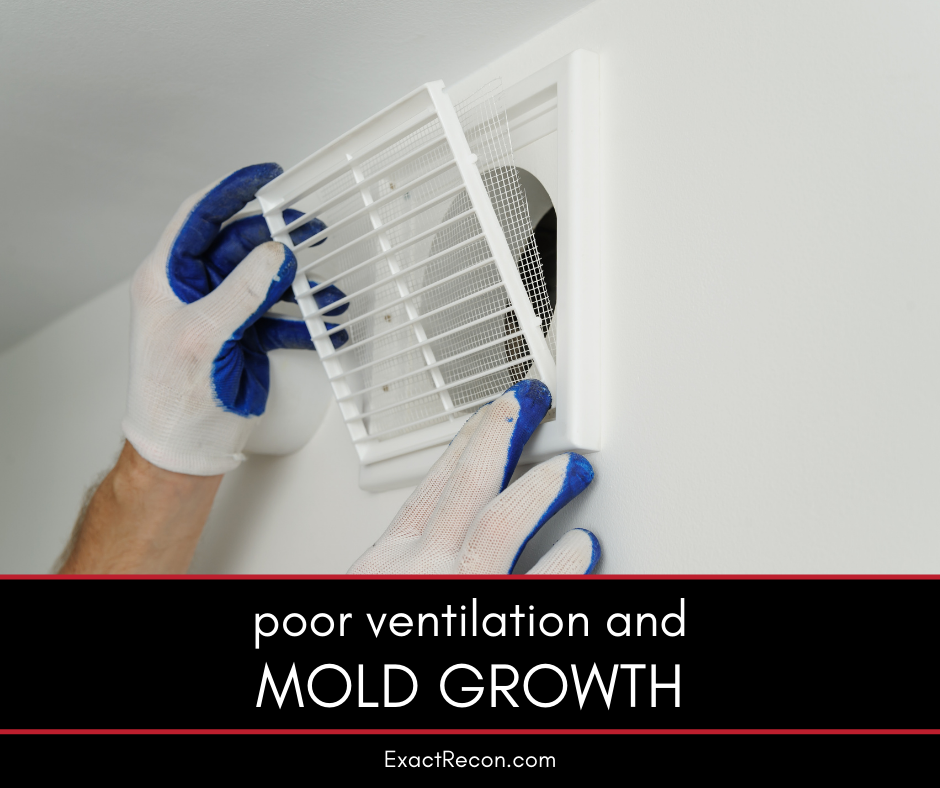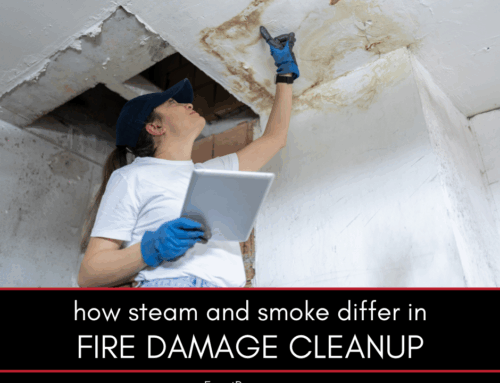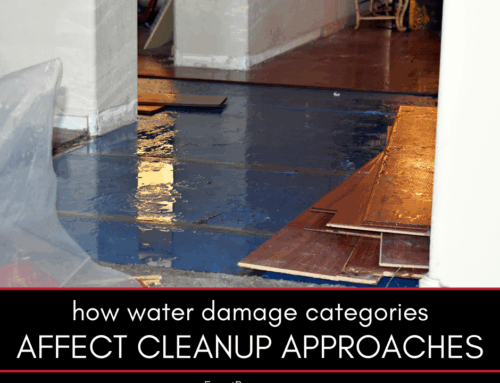Poor ventilation in your home can create the perfect environment for mold growth. Mold thrives in damp, stagnant areas, and a lack of proper airflow allows moisture to linger, increasing the risk of mold infestations. Mold not only damages your property but also poses significant health risks. This guide explains the connection between poor ventilation and mold growth and how to address the issue effectively.
What You Need to Know About Poor Ventilation and Mold Growth
Poor ventilation is a leading cause of mold problems in homes. This guide covers:
- How poor ventilation leads to mold growth
- Health risks associated with mold
- Signs of poor ventilation and mold issues
- Steps to improve ventilation and prevent mold
- When to call Exact Recon for professional assistance
Here’s a closer look at each.
How Poor Ventilation Leads to Mold Growth
Mold requires moisture, warmth, and organic material to grow. Poor ventilation traps humid air, creating the ideal conditions for mold development. Without proper airflow, moisture from cooking, bathing, or even breathing accumulates, particularly in confined spaces like bathrooms, kitchens, and basements.
In addition to high humidity, poor ventilation can cause condensation on windows, walls, and ceilings. This condensation provides a water source that mold can exploit, spreading quickly across surfaces. Areas like attics and crawl spaces are especially vulnerable, as they often lack sufficient ventilation and temperature regulation.
Health Risks Associated With Mold
Mold growth in your home isn’t just an aesthetic issue—it can have serious implications for your health. Mold releases spores into the air, which can cause:
- Allergic reactions: Symptoms include sneezing, runny nose, itchy eyes, and skin rashes.
- Respiratory issues: Inhaling mold spores can lead to asthma attacks, shortness of breath, and other respiratory problems.
- Infections: Prolonged exposure to mold can increase the risk of lung infections, especially in individuals with weakened immune systems.
- Toxic effects: Certain molds, such as black mold, release mycotoxins that can cause severe health issues, including chronic fatigue, headaches, and neurological problems.
Signs of Poor Ventilation and Mold Issues
Recognizing the signs of poor ventilation and mold growth can help you address the problem before it escalates. Look for:
- Persistent humidity or condensation on windows and walls
- Musty odors in certain rooms or areas
- Visible mold growth on walls, ceilings, or furniture
- Peeling paint or wallpaper
- Increased allergy or respiratory symptoms among household members
If you notice these signs, it’s essential to act quickly to improve ventilation and address any existing mold.
Steps to Improve Ventilation and Prevent Mold
Preventing mold growth starts with addressing poor ventilation. Follow these steps to improve airflow and reduce humidity in your home:
- Use exhaust fans: Install and use exhaust fans in high-humidity areas like bathrooms, kitchens, and laundry rooms. Ensure the fans vent outside, not into an attic or crawl space.
- Open windows and doors: When weather permits, open windows and doors to allow fresh air to circulate and reduce indoor humidity.
- Install a dehumidifier: Use a dehumidifier in areas prone to high humidity, such as basements or bathrooms. Maintain indoor humidity levels below 50%.
- Ensure proper attic and crawl space ventilation: Check that vents are unobstructed and functioning properly to regulate temperature and airflow in these areas.
- Seal leaks and insulate pipes: Fix leaks and insulate pipes to prevent condensation, which can contribute to moisture buildup.
- Clean HVAC systems: Regularly clean and maintain HVAC systems to improve indoor air circulation and reduce the risk of mold.
When to Call Exact Recon for Professional Assistance
If mold growth is already present or you’re struggling to address poor ventilation, it’s time to call the experts at Exact Recon. Our team specializes in mold remediation and can help identify and resolve underlying ventilation issues to prevent future mold problems.
We use advanced tools and techniques to eliminate mold, sanitize affected areas, and ensure your home is safe and healthy. Don’t let poor ventilation and mold growth compromise your property—contact Exact Recon for expert solutions.
FAQ About Poor Ventilation and Mold Growth
Check out these commonly asked questions about poor ventilation and mold growth. If you don’t see your question here, please call our office and we’ll find you the answers you need.
How Does Poor Ventilation Cause High Humidity?
Poor ventilation traps moisture-laden air inside your home, preventing it from escaping. This leads to high humidity levels, which encourage mold growth.
Can Mold Grow in Well-Ventilated Areas?
While good ventilation reduces the risk, mold can still grow in well-ventilated areas if there’s a water source, such as a leak or condensation.
How Can I Tell if Mold Is Hidden in My Home?
Signs of hidden mold include musty odors, increased allergy symptoms, and discoloration on walls or ceilings. A professional inspection can confirm its presence.
Is Poor Ventilation the Only Cause of Mold Growth?
No, mold growth can also result from leaks, flooding, or poor maintenance. However, poor ventilation significantly increases the risk by allowing moisture to accumulate.
Does Insurance Cover Mold Remediation?
Insurance coverage for mold remediation depends on the cause of the mold. Sudden and accidental events may be covered, but issues stemming from neglect typically are not. Check your policy for details.
Poor ventilation can lead to mold growth, creating serious risks for your home and health. By improving airflow and addressing humidity issues, you can prevent mold and maintain a safe, comfortable living environment. Trust Exact Recon for professional mold remediation and ventilation solutions.
Do You Need a Disaster Remediation Expert in Washtenaw County or Jackson County?
If your home has already been damaged, we can help. Check out our services and get a free disaster remediation quote today. We offer:
- Water damage restoration
- Fire damage restoration
- Mold removal and remediation
- Fire and smoke restoration
- Sewer cleanup and disinfecting
- Reconstruction
- Wind and storm damage repair









